Some watches stick in your mind like a splinter; for me, the IWC Pilot’s Watch Chronograph Spitfire is one of them. I’ve been a Chronograph fan since the very early days of my horological journey. I remember walking into my local AD, Seiko SKX on my wrist, and lusting over Speedmasters, IWC Le Petit Princes, and JLC Polaris Chronographs. As the years went on I invested more money into watches and I had the opportunity to own several of those other pieces that I was pining over.
I’ve owned more Omega Speedmasters than I’d care to admit. I was able to wear a 43mm Le Petit Prince for the better part of a year. I never quite got to the JLC level though (yet)… but in my exploration of all things chronograph-related I was particularly excited back in 2019 when IWC Schaffhausen announced a smaller-sized pilot’s chronograph that was powered by their new in-house 69000 series automatic movement.
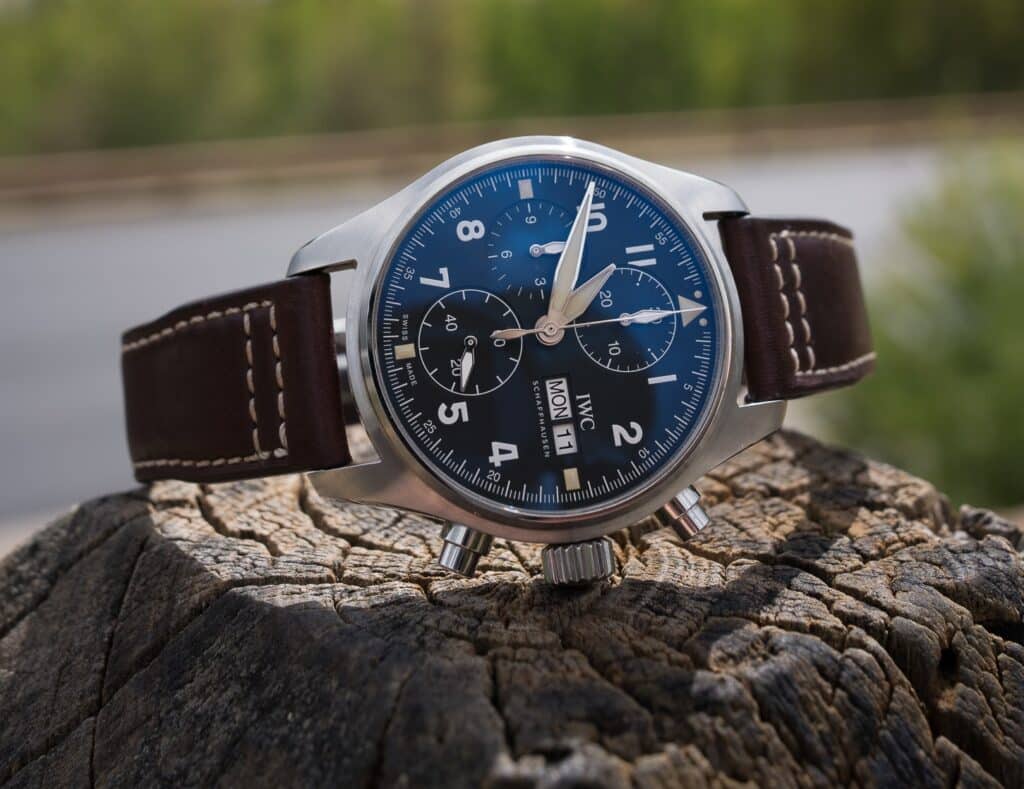
This watch was of course the IWC Spitfire Chronograph. During my time with the Le Petit Prince, I discovered that the 43mm case size paired with the longer lug-to-lug length made for a watch that was somewhat uncomfortable for my 7.5” wrist. So the overall trimmed-down size of the Spitfire was a homerun for my wrist.
IWC Spitfire Chronograph Specs
| Case Dimensions | 41mm x 51.5mm x 15.5mm |
| Lug Width | 20mm |
| Material | Stainless Steel |
| Crystal | Sapphire |
| Water Resistance | 6 Bar |
| Movement | Caliber 69380 |
| Power Reserve | 46 Hours |
The Spitfire isn’t something new to IWC’s but it wasn’t until 2012 that they became their own “line” within the brand. Before that, they were just versions of existing models in IWC’s catalog. What makes the 2019 IWC Spitfire special is that it was the first time IWC used a 69000-series movement in their pilot’s watches. We’ll get into more detail on the movement itself later, but this allowed them to trim the size down to 41mm. This size reduction resulted in a much more wearable watch and a must-have for Aaron’s wrist.
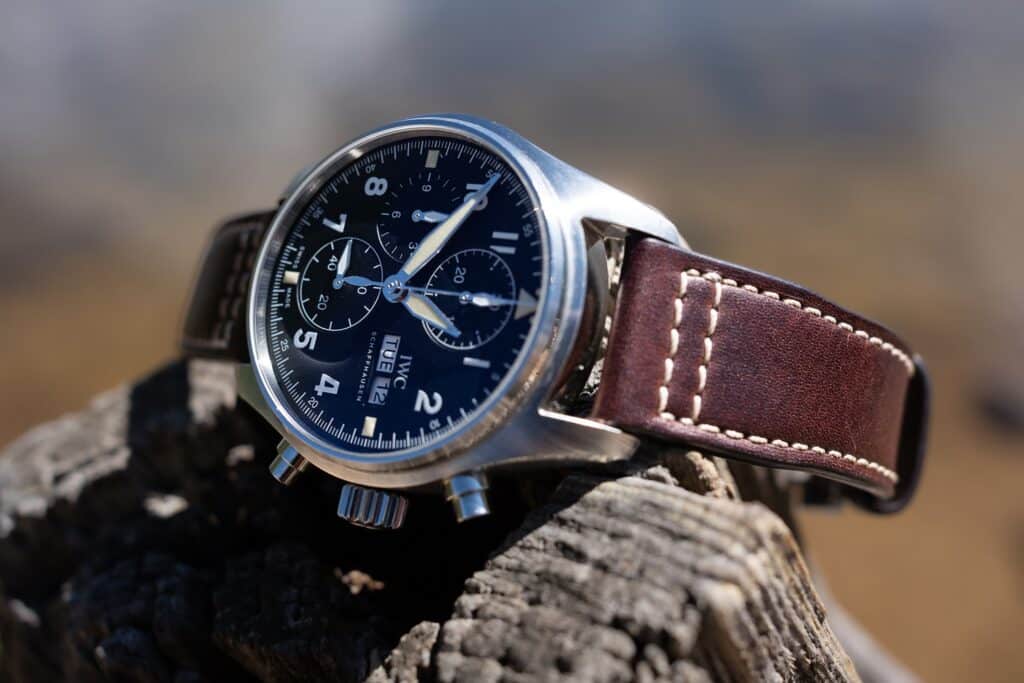
A Simple, But Well-Proportioned Stainless Steel Case
The IWC Spitfire Chronograph features a 41mm wide x 51.5mm lug-to-lug x 15.5mm thick stainless steel case. By all accounts, this sounds like a large/thick case for a watch someone is likely to wear daily. But here’s my experience… on my 7.5” (19cm) wrist the lug to lug places the watch perfectly on the flat of my arm. If you’re under a 7” wrist size then this might be a little too much watch for you and I’d point you towards the three-hander mark series. The thickness isn’t an issue for me, I can’t remember the last time I wore a “cuff” that a watch needed to fit under.
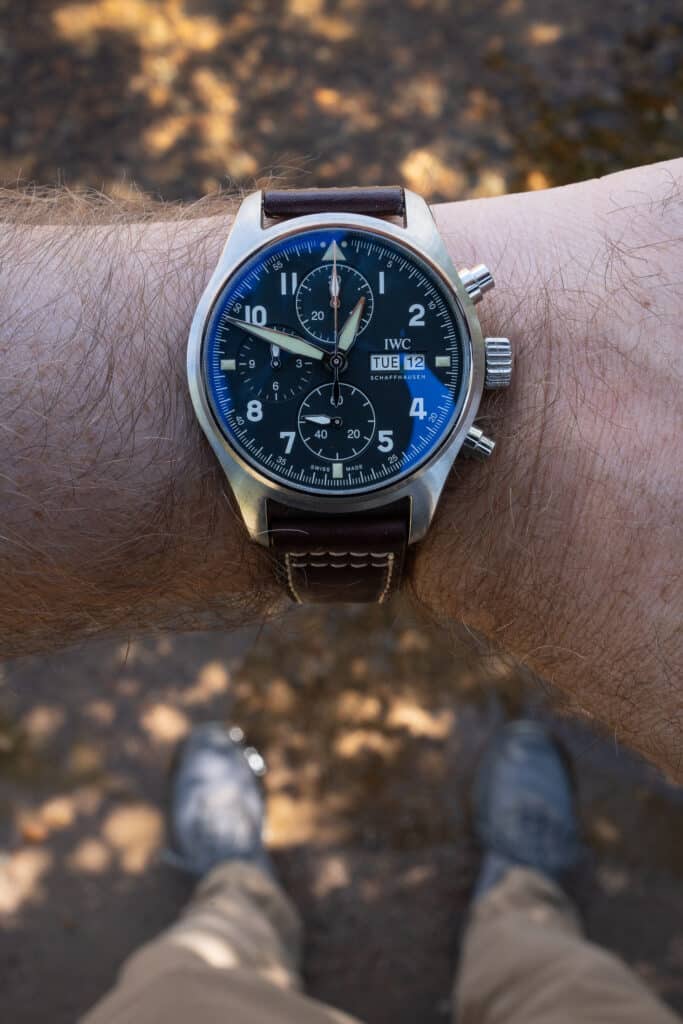
Cases finishes are simple, as you’d expect for a timepiece firmly rooted in “tool watch” heritage. The case is brushed throughout except for the bevel on the lugs, which is polished, and a very thin bezel around the crystal which is also polished. If you flip the watch over you’re treated to a really awesome engraving of the Supermarine Spitfire and it’s famous elliptical wing design. The raised portions on the caseback are polished as well.
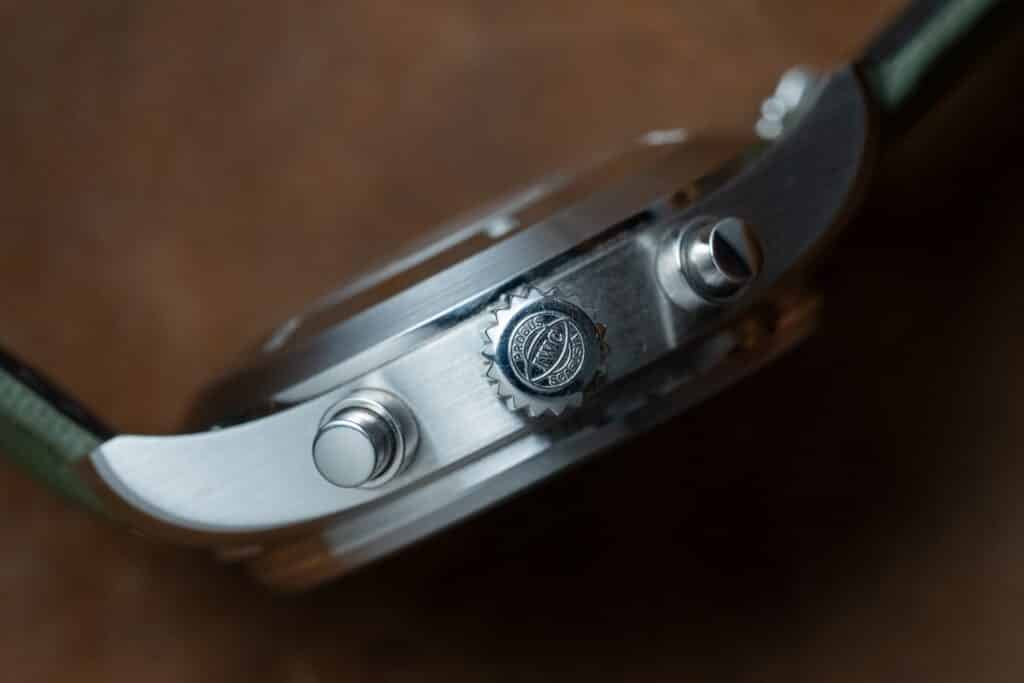
On the right side of the case, you have the “controls.” You have two 3.8mm-ish pusher buttons, very classic, and a nicely oversized 7mm screw-down crown. This all feels nice and proportional to the overall watch. The screw-down crown is easy to grip when you’re setting the time and likely is the main contributing factor to the 60 meters of water resistance.
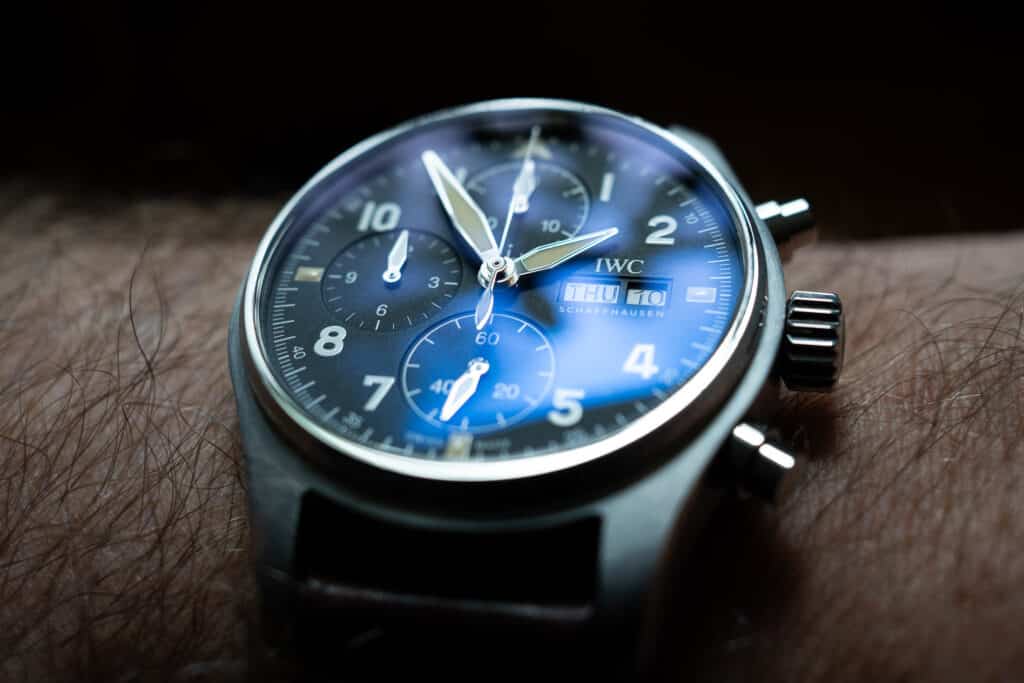
On top, you’ve got a nicely convexed sapphire crystal that’s double AR coated. IWC states that the sapphire crystal is, “secured against displacement by drop in air pressure.” Which -ahem- I have been unable to test, but I believe them and it sounds super cool.
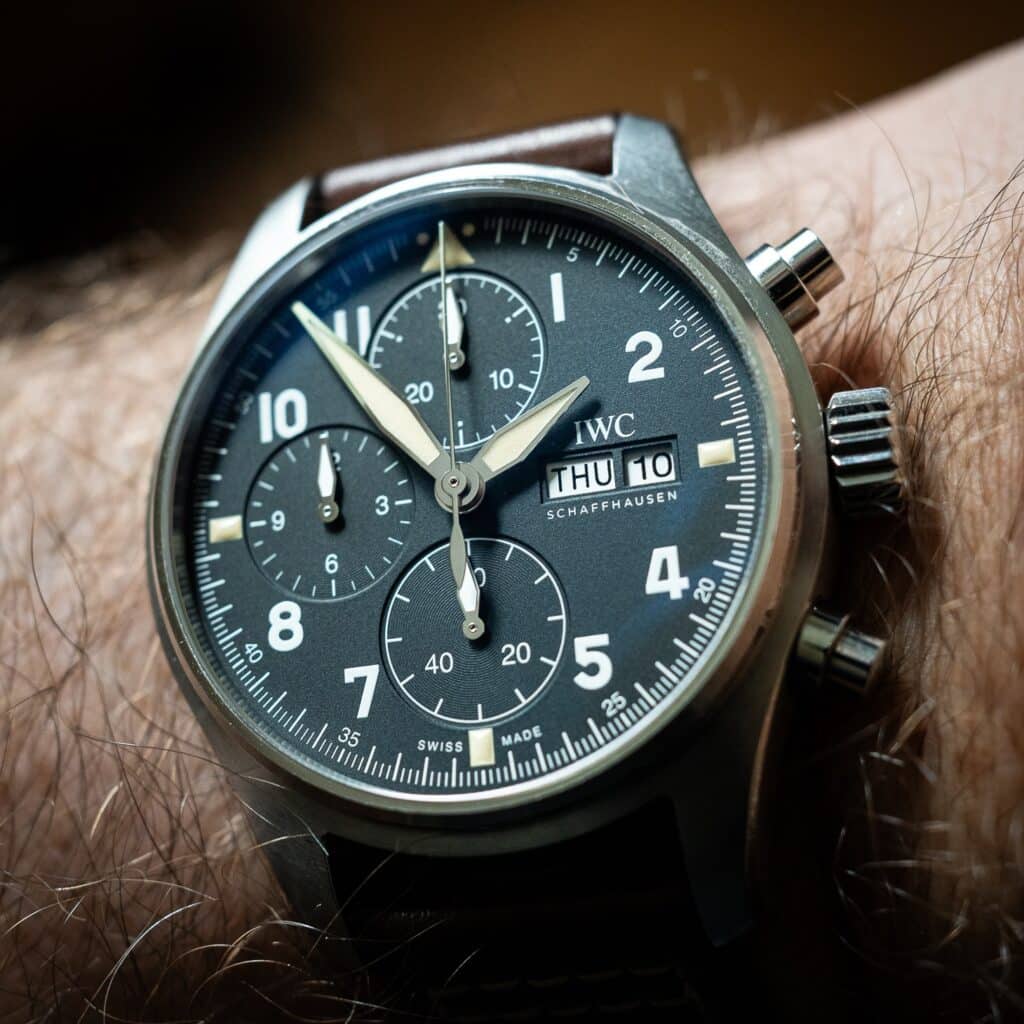
Classic Pilot Watch Dial Needing More Lume
I love a pilot watch’s dial. The IWC’s features a matte black dial with slightly recessed sub-dials, a day/date display at 3 o’clock, Arabic numerals on all the hours apart from the quarter hours, and tan lume at the quarters and on the hands. The Spitfire does something that I’ve come to love in certain watches; the details on the dial and hands sparkle as the watch moves through the light on your wrist. Not all watches accomplish this same type of “faceting” in my experience, but IWC knocked it out of the park with this one.
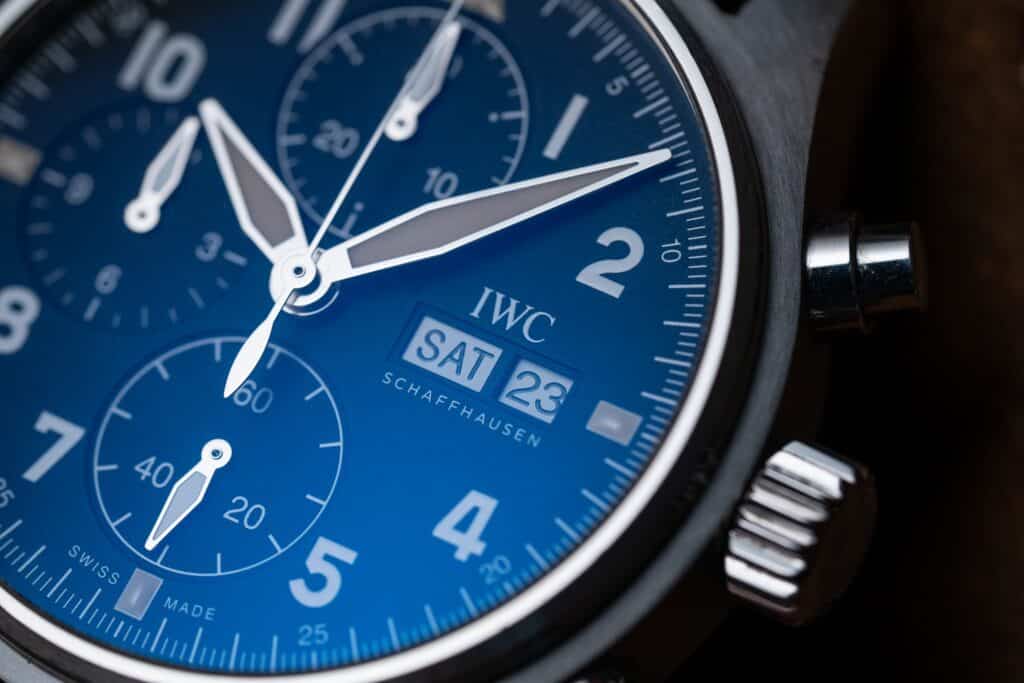
Something worth bringing up on this watch is the color of the lume vs. the color of the rest of the printing on the dial. The Arabic numerals, IWC logo, and minute/second track are all pure white. The hands and quarter hour markers on the other hand are a tan/aged/faux patinaed lume. This is the marmite quality of this watch. You’ll love it or you’ll hate it and I can appreciate both sides of that… I like it, personally.
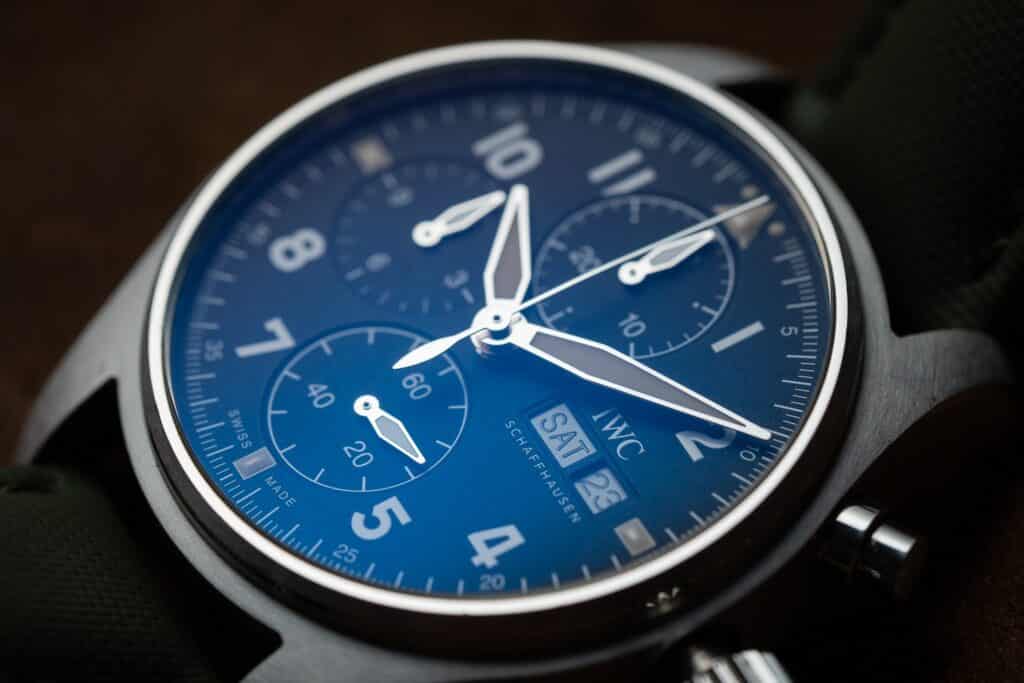
The hands are the traditional pilot’s sword hands. I love these hands on a watch. They’re long, with the minute hand reaching almost to the very edge of the dial. The hour is like a stubby mini version of the hour. Each of the subdial hands are also a mini swords. All the hands have polished surrounds with lume (on the hour and minute) and white paint for the sub-dials. They’re great, and the hands are the majority of the “jewel-like” quality I mentioned above.
If I was going to offer some constructive criticism of the dial or maybe a wishlist for the next Spitfire I’d just ask for more lume. It’s a shame to only have the hands and quarter-hour indices lumed.
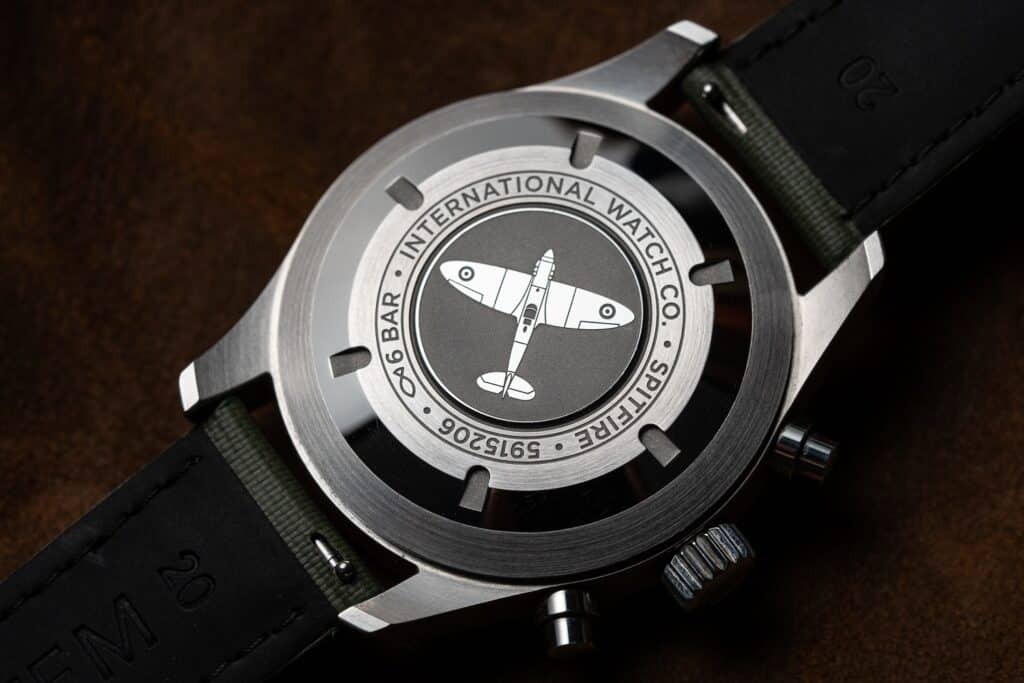
Built On The Calibre 69380 Movement
The movement in this generation of the IWC Spitfire is one of the standouts from its initial release. The Spitfire is powered by the IWC Calibre 69380, which is a 33 jewel, 4hz column wheel chronograph movement that boasts a 46hr power reserve. This movement being put into the pilot line was a direct move by IWC to get their pilot chronographs away from the Swatch-supplied ETA/Valjoux chronograph movements. In my opinion “in-house” movements are just the frosting on top of a nicely designed watch. I’ve owned a Le Petit Price before that had a 7750 in it and that never bothered me.
Performance-wise, the movement has been spot on COSC spec with a crisp break when activating the chronograph with a decisive snap resetting back. The minute totalizer snaps over as the chrono hand reaches 12, the hour totalizer on the other hand is progressive so it slowly moves along the sub-dial as the chrono runs. If I could add another item to the imaginary IWC wishlist for the next Spitfire it would be for a longer power reserve. 46 hours is…fine, but I’d love 72+. Three days + is becoming the standard for newer, and in particular, in-house movements. The movement is also surrounded by a soft-iron enclosure to help deflect the impact of magnetic fields from impeding the watch’s accuracy.
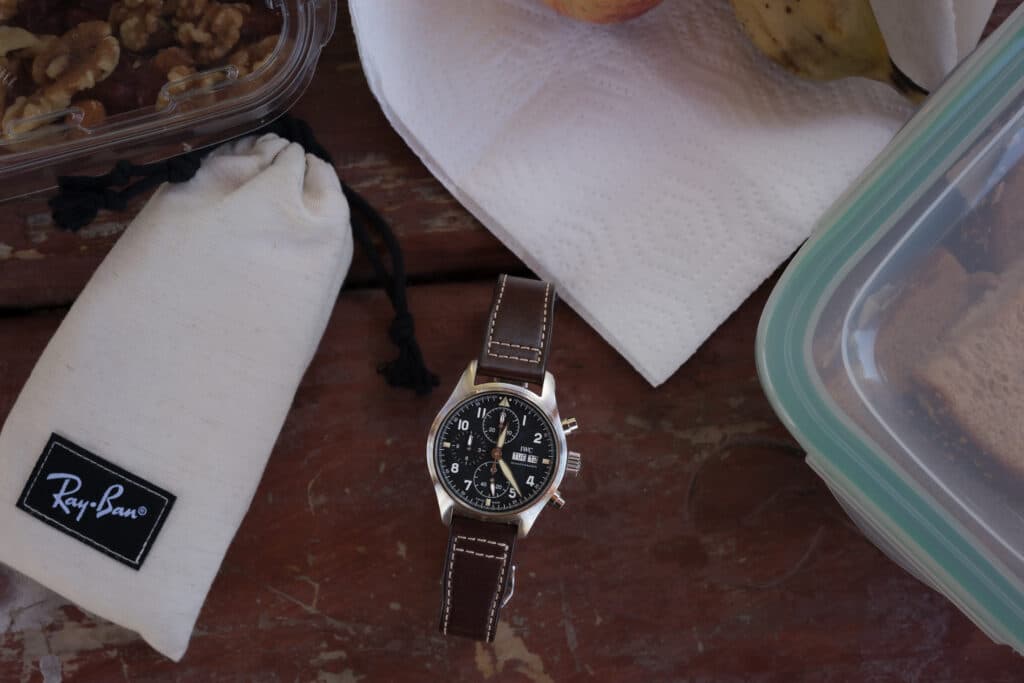
Hard To Go Wrong With Any Strap Pairing
The Spitfire is available on two different straps from IWC. A leather strap or a canvas/green textile strap and a pin buckle. I have the brown leather strap on mine and I replaced the pin buckle with an aftermarket deployant. All of these OEM strap options are excellent, very well made, and will last a long time. That being said, these watches are also strap monsters.
I’ve worn this watch on a Crown and Buckle Matte Supreme NATO, an Artem Sailcloth Strap, a Haveston nylon pilot style strap, and the OEM leather. Moving the watch between textile and leather straps allows you to dress the watch up or down as needed. I will say that putting a 15mm thick watch on a NATO can make for a “tall” wearing experience, but it’s not that bad.
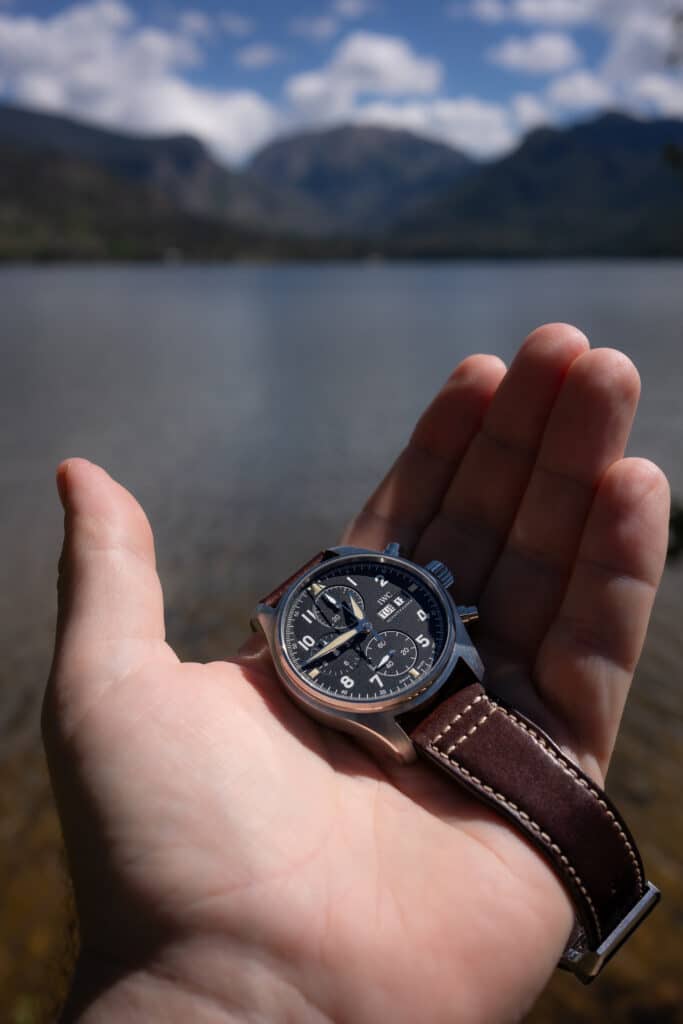
Overall Thoughts
How do I summarize my thoughts on the IWC Spitfire? This is a watch that’s made by a truly iconic Swiss watch brand. IWC is known for its accuracy and high level of refinement but all of that doesn’t come without paying for it. The IWC Spitfire Chronograph is currently listed on IWC’s website for $7400 on the textile strap. I paid significantly less than that preowned. Do I feel like it’s worth that price tag? New? ….. Maybe. Is it worth the slightly more than half that I paid? Yes, decidedly yes. That’s only if you like the aesthetics of an IWC though.
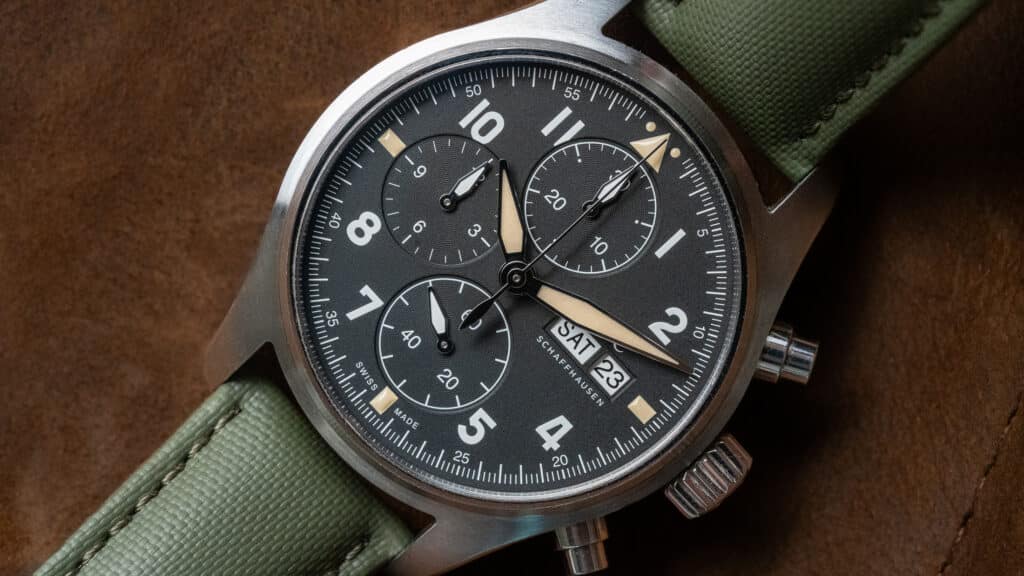
Even at secondary market prices, you’re creeping close to a Speedmaster’s price. You could also look at some of the older versions of the IWC Pilot’s Chronographs they come in a variety of colors and sizes. The Spitfire is even available in a bronze case that I’d 100% cop if the opportunity presented itself. There are MANY cheaper options you can explore in the pilot watch/chronograph space but if you’re looking at IWCs you’re probably looking at a particular, for lack of a better term, level of watch. You’re going to want the Speedmasters, the Spitfires, or the Navitmers of the world.
For the sake of argument, however, you might take a gander at the Sinn 356 or 103’s. These are (very German) pilot’s chronographs that will maintain some of the same aesthetics the IWC has but at the 2.5-3k price point (new).

Aaron is a Nashville based watch collector and road bike rider. In addition to TBWS, his articles can been seen on ABlogtoWatch and Bladereviews.com. Aaron’s interests primarily focus on tool watches — specifically in the dive, pilot, or field watch arenas. When not over enthusiastically asking someone about the watch they’re wearing, Aaron can be found traveling, cycling, trying new restaurants with his partner Carissa, or petting any and all dogs within his sightline.
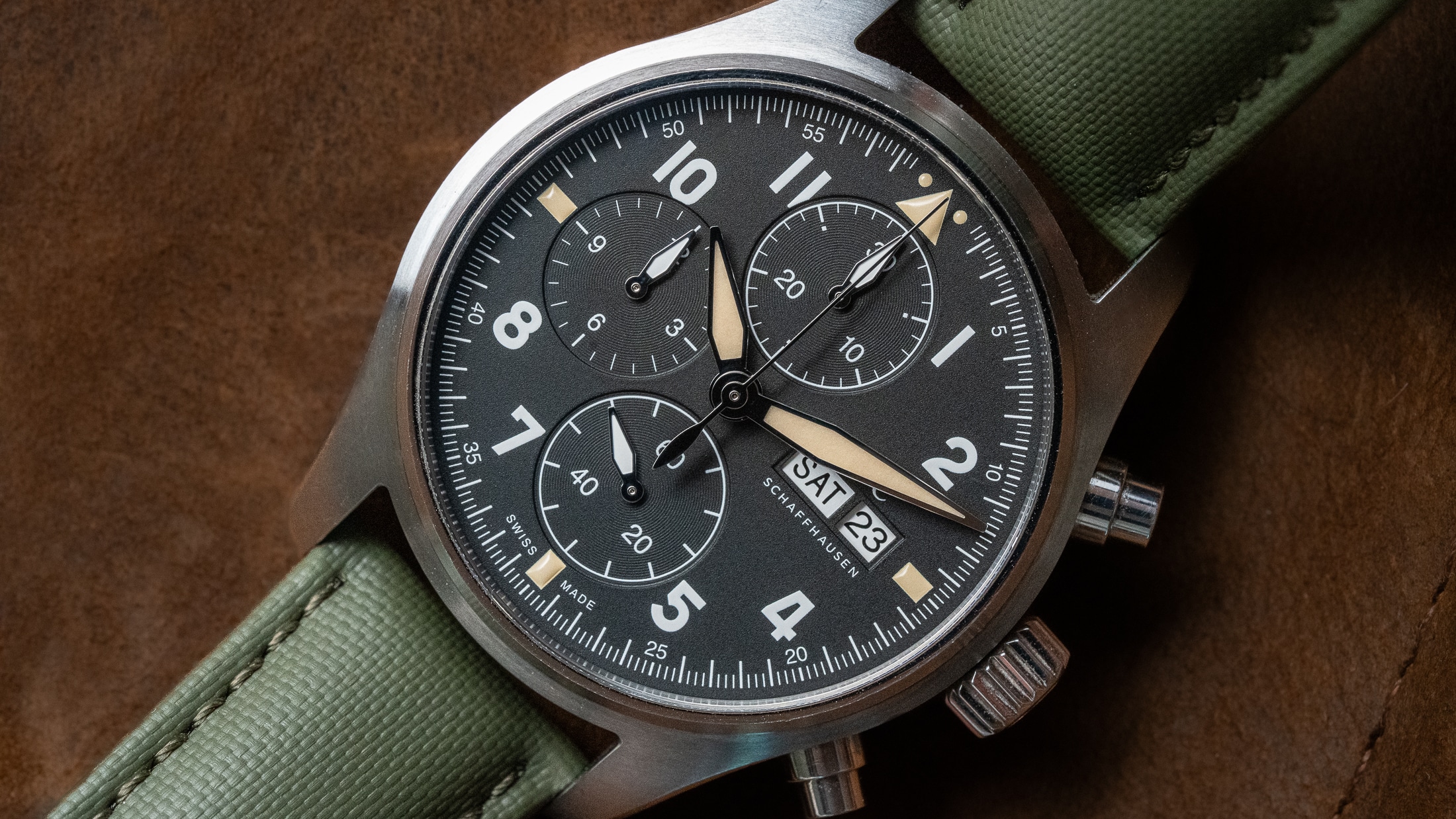
I’m always curious about the need to replace a simple and elegant pin buckle with a heavy and more complicated deployant.
So what came first the IWC or Damasko DC56? I find it odd you mention Sinn but not the DC56 that has an uncanny similarity to this watch at less than 1/3 the price. The DC56 arguably has superior materials and engineering when it comes to the case. The Ice Hardened finish is no marketing hype as mines survived more than its share of knocks and scrapes without a single blemish yet to appear. Yea, its got a 7750 but its also less than 1/3 the price.
Damasco? Sinn? Please. Read a little horological history before nonsensical comments like this.